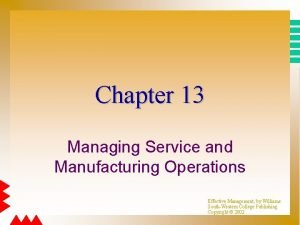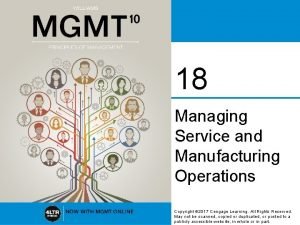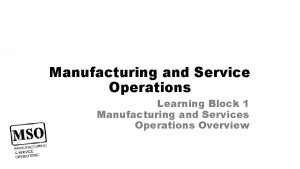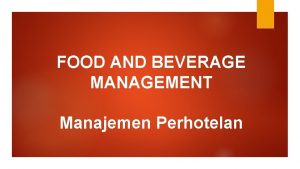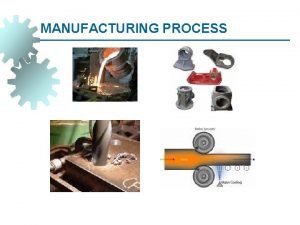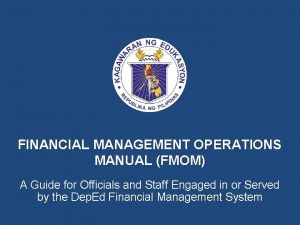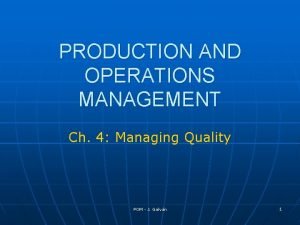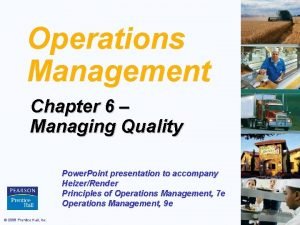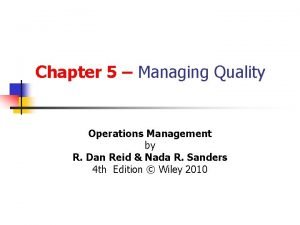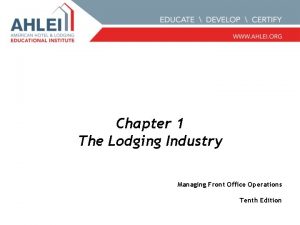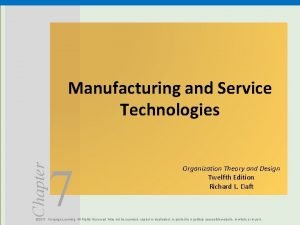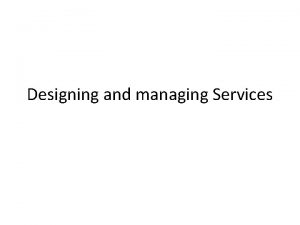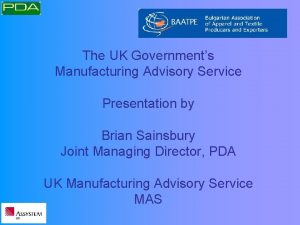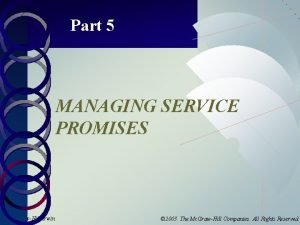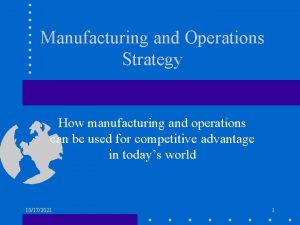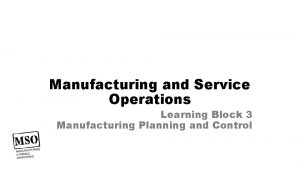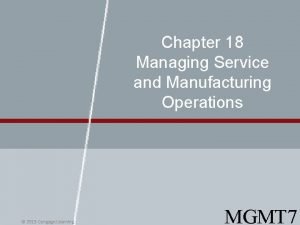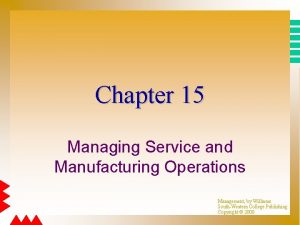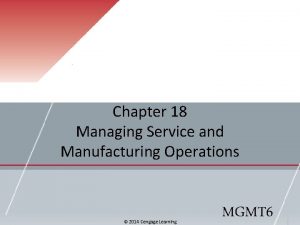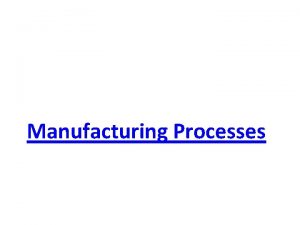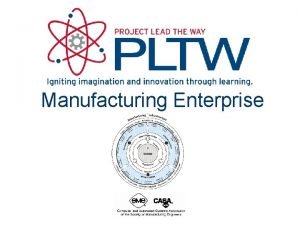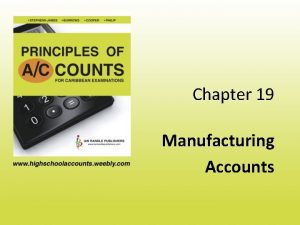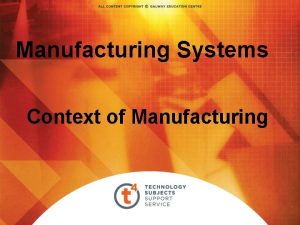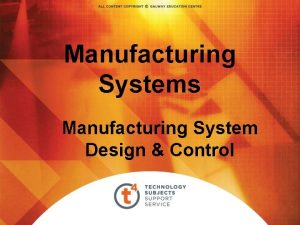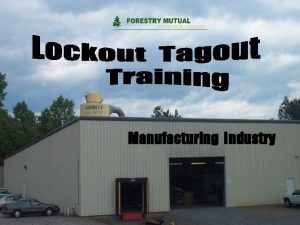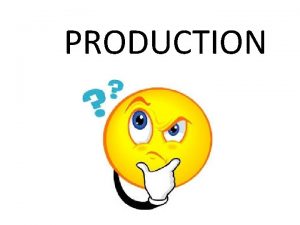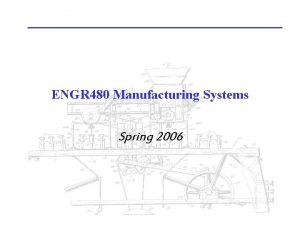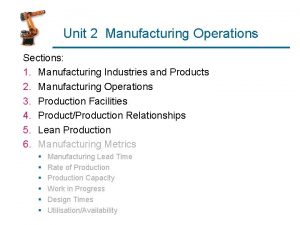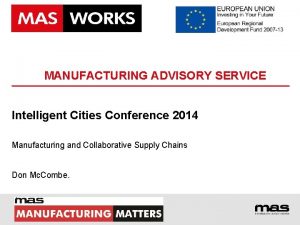18 Managing Service and Manufacturing Operations Copyright 2016




















- Slides: 20

18 Managing Service and Manufacturing Operations Copyright © 2016 Cengage Learning. All Rights Reserved. May not be scanned, copied or duplicated, or posted to a publicly accessible website, in whole or in part.

LEARNING OUTCOMES 1 Discuss the kinds of productivity and their importance in managing operations 2 Explain the role that quality plays in managing operations 3 Explain the essentials of managing a service business 4 Describe the different kinds of manufacturing operations 5 Explain why and how companies should manage inventory levels Copyright © 2016 Cengage Learning. All Rights Reserved. May not be scanned, copied or duplicated, or posted to a publicly accessible website, in whole or in part. MGMT 8 | CH 3 2

Productivity • Higher productivity results in: • Lower costs for the company, lower prices • Faster service, higher market share • Higher standard of living and increased profits • Kinds • Partial productivity: Measure of performance that indicates how much of a particular kind of input it takes to produce an output • Multifactor productivity: Indicates how much labor, capital, materials, and energy it takes to produce an output Copyright © 2016 Cengage Learning. All Rights Reserved. May not be scanned, copied or duplicated, or posted to a publicly accessible website, in whole or in part. MGMT 8 | CH 3 3

Quality-Related Characteristics for Products and Services • Characteristics of quality product • Reliability • Serviceability • Durability • Characteristics of quality service • • Reliability Tangibles Responsiveness Assurance and empathy Copyright © 2016 Cengage Learning. All Rights Reserved. May not be scanned, copied or duplicated, or posted to a publicly accessible website, in whole or in part. MGMT 8 | CH 3 4

ISO 9000 and 14000 • ISO 9000: Series of five international standards, from ISO 9000 to ISO 9004 • For achieving consistency in quality management and quality assurance in companies throughout the world • ISO 14000 • Series of international standards for managing, monitoring, and minimizing an organization’s harmful effects on the environment Copyright © 2016 Cengage Learning. All Rights Reserved. May not be scanned, copied or duplicated, or posted to a publicly accessible website, in whole or in part. MGMT 8 | CH 3 5

Total Quality Management (TQM) • Integrated, principle-based, organizationwide strategy for improving product and service quality • Principles • Customer focus and satisfaction • Continuous improvement • Teamwork Copyright © 2016 Cengage Learning. All Rights Reserved. May not be scanned, copied or duplicated, or posted to a publicly accessible website, in whole or in part. MGMT 8 | CH 3 6

Exhibit 18. 4 Service-Profit Chain Sources: R. Hallowell, L. A. Schlesinger, and J. Zornitsky, “Internal Service Quality, Customer and Job Satisfaction: Linkages and Implications for Management, ” Human Resource Planning 19 (1996): 20– 31; J. L. Heskett, T. O. Jones, G. W. Loveman, W. E. Sasser Jr. , and L. A. Schlesinger, “Putting the Service-Profit Chain to Work, ” Harvard Business Review (March–April 1994): 164– 174. Copyright © 2016 Cengage Learning. All Rights Reserved. May not be scanned, copied or duplicated, or posted to a publicly accessible website, in whole or in part. MGMT 8 | CH 3 7

Service Recovery and Empowerment • Service recovery: Restoring customer satisfaction to strongly dissatisfied customers • Requires service employees to fix mistakes and perform heroic service acts • Empowering workers • Giving service employees the authority and responsibility to make decisions that immediately solve customer problems Copyright © 2016 Cengage Learning. All Rights Reserved. May not be scanned, copied or duplicated, or posted to a publicly accessible website, in whole or in part. MGMT 8 | CH 3 8

Amount of Processing in Manufacturing Operations Make-to-order operation • Does not start processing or assembling products until a customer order is received Assemble-to-order operation • Divides manufacturing processes into modules that are combined to create semi customized products Make-to-stock operation (build-to-stock) • Orders parts and assembles standardized products before receiving customer orders Copyright © 2016 Cengage Learning. All Rights Reserved. May not be scanned, copied or duplicated, or posted to a publicly accessible website, in whole or in part. MGMT 8 | CH 3 9

Flexibility of Manufacturing Operations Continuous-flow production • Produces goods at a continuous, rather than a discrete, rate • Least flexible Line-flow production • Preestablished and occur in a serial or linear manner • Inflexible Batch production • Produces goods in large batches in standard lot sizes • Most flexible • Job shops: Handle custom orders or small batch jobs Copyright © 2016 Cengage Learning. All Rights Reserved. May not be scanned, copied or duplicated, or posted to a publicly accessible website, in whole or in part. MGMT 8 | CH 3 10

Types of Inventory Raw material inventories • Basic inputs in a manufacturing process Component parts inventories • Basic parts used in manufacturing that are fabricated from raw materials Work-in-process inventories • Partially finished goods consisting of assembled component parts Finished goods inventories • Final outputs of manufacturing operations Copyright © 2016 Cengage Learning. All Rights Reserved. May not be scanned, copied or duplicated, or posted to a publicly accessible website, in whole or in part. MGMT 8 | CH 3 11

Measuring Inventory • Average aggregate inventory • Average overall inventory during a particular time period • Weeks of supply • Number of weeks required by a company to run out of its current supply of inventory • Inventory turnover • Number of times per year that a company sells, or turns over, its average inventory Copyright © 2016 Cengage Learning. All Rights Reserved. May not be scanned, copied or duplicated, or posted to a publicly accessible website, in whole or in part. MGMT 8 | CH 3 12

Costs of Maintaining an Inventory Ordering cost Setup cost Holding cost Stockout cost Copyright © 2016 Cengage Learning. All Rights Reserved. May not be scanned, copied or duplicated, or posted to a publicly accessible website, in whole or in part. MGMT 8 | CH 3 13

Inventory Management Techniques Economic order quantity (EOQ) • System of formulas that minimizes ordering and holding costs • Helps determine how much and how often inventory should be ordered Just-in-time (JIT) inventory • Component parts arrive from suppliers just as they are needed at each stage of production Materials requirement planning (MRP) • Determines the production schedule, production batch sizes, and inventory needed to complete final products Copyright © 2016 Cengage Learning. All Rights Reserved. May not be scanned, copied or duplicated, or posted to a publicly accessible website, in whole or in part. MGMT 8 | CH 3 14

Managing Inventory • EOQ is used with independent demand systems • Independent demand system: Level of one kind of inventory does not depend on another • JIT and MRP are used with dependent demand systems • Dependent demand system: Level of inventory depends on the number of finished units to be produced Copyright © 2016 Cengage Learning. All Rights Reserved. May not be scanned, copied or duplicated, or posted to a publicly accessible website, in whole or in part. MGMT 8 | CH 3 15

SUMMARY • Higher productivity results in lower costs for the company, lower prices, faster service, higher market share, and higher profits • High-value service leads to customer satisfaction and customer loyalty which in turn leads to long-term profits and growth • Inventory is the amount and number of raw materials, parts, and finished products that a company has in its possession Copyright © 2016 Cengage Learning. All Rights Reserved. May not be scanned, copied or duplicated, or posted to a publicly accessible website, in whole or in part. MGMT 8 | CH 3 16

KEY TERMS • Operations management • Productivity • Partial productivity • Multifactor productivity • Quality • ISO 9000 • ISO 14000 • Total quality management (TQM) • Customer focus • Customer satisfaction • Continuous improvement • Variation • Teamwork • Internal service quality • Service recovery • Make-to-order operation Copyright © 2016 Cengage Learning. All Rights Reserved. May not be scanned, copied or duplicated, or posted to a publicly accessible website, in whole or in part. MGMT 8 | CH 3 17

KEY TERMS • Assemble-to-order operation • Make-to-stock operation • Manufacturing flexibility • Continuous-flow production • Line-flow production • Batch production • Job shops • Inventory • Raw material inventories • Component parts inventories • Work-in-process inventories • Finished goods inventories • Average aggregate inventory Copyright © 2016 Cengage Learning. All Rights Reserved. May not be scanned, copied or duplicated, or posted to a publicly accessible website, in whole or in part. MGMT 8 | CH 3 18

KEY TERMS Stockout Inventory turnover Ordering cost Setup cost Holding costs Stockout costs Economic order quantity (EOQ) • Just-in-time (JIT) inventory system • Kanban • • Materials requirement planning (MRP) • Independent demand system • Dependent demand system Copyright © 2016 Cengage Learning. All Rights Reserved. May not be scanned, copied or duplicated, or posted to a publicly accessible website, in whole or in part. MGMT 8 | CH 3 19

Copyright © 2016 Cengage Learning. All Rights Reserved. May not be scanned, copied or duplicated, or posted to a publicly accessible website, in whole or in part. MGMT 8 | CH 3 20
 Managing service and manufacturing operations
Managing service and manufacturing operations Managing service and manufacturing operations
Managing service and manufacturing operations Difference between manufacturing and service operations
Difference between manufacturing and service operations Pengertian food and beverage product
Pengertian food and beverage product Manufacturing cost vs non manufacturing cost
Manufacturing cost vs non manufacturing cost Job vs process costing
Job vs process costing Cost concept and classification
Cost concept and classification Manufacturing cost vs non manufacturing cost
Manufacturing cost vs non manufacturing cost Additively
Additively Classification of production system
Classification of production system System center operations manager
System center operations manager Financial management operations manual deped
Financial management operations manual deped Managing quality in operations management
Managing quality in operations management Managing quality in operations management
Managing quality in operations management Managing quality in operations management
Managing quality in operations management Managing front office operations 10th edition
Managing front office operations 10th edition Manufacturing and service technologies
Manufacturing and service technologies Designing and managing services
Designing and managing services 7 types of jaycustomers
7 types of jaycustomers Manufacturing advisory service uk
Manufacturing advisory service uk Managing service promises
Managing service promises
